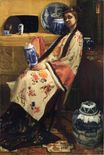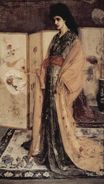James McNeill Whistler - Purple and Rose. The Lang Leizen of the Six Marks 1864
 |
 |
 |
 |
 |
 |
 |

Purple and Rose. The Lang Leizen of the Six Marks 1864
61x92cm oil/canvas
Philadelphia Museum of Art
<< Previous G a l l e r y Next >>
From Philadelphia Museum of Art:
James Abbott McNeill Whistler was a leading figure in the Aesthetic movement, which rejected the rich, stuffiness of Victorian taste in favor of a style defined by spareness, delicacy, and refinement. Central to his concept of design were Asian objects from his personal collection, such as the ceramics and the woman's embroidered Chinese robe in Purple and Rose: The Lange Leizen of the Six Marks. After the names of the colors that set the painting's tone--Whistler's way of emphasizing that his works are primarily abstract compositions of colors--the title refers to the seventeenth-century Chinese porcelain jar that the young woman holds. Lange Leizen, a Dutch phrase that Whistler translates as "Long Elizas," refers to such ware decorated with elongated figures. The Six Marks are the potter's marks on the bottom of the jar. Although Whistler's depiction of a Chinese pottery shop is much more akin to contemporary genre scenes than to his later, more adventurous compositions influenced by Japanese prints, he carved the potter's marks into the gilded frame to enhance the exoticism of the subject.
Darrel Sewell, from Philadelphia Museum of Art: Handbook of the Collections (1995), p. 283.